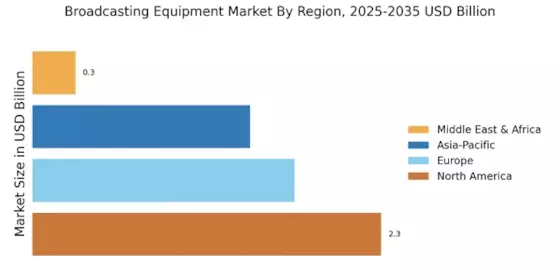Technological Advancements
The Broadcasting Equipment Market is experiencing rapid technological advancements that enhance the quality and efficiency of broadcasting. Innovations such as 4K and 8K resolution cameras, along with advanced audio equipment, are becoming standard. These technologies not only improve viewer experience but also increase production capabilities. The market for broadcasting equipment is projected to grow at a compound annual growth rate of approximately 6.5% from 2025 to 2030, driven by these advancements. Furthermore, the integration of cloud-based solutions allows for more flexible and scalable broadcasting operations, which is particularly appealing to smaller broadcasters looking to compete with larger entities. As technology continues to evolve, the Broadcasting Equipment Market is likely to see increased investment in state-of-the-art equipment.
Growing Demand for Live Content
The demand for live content is surging, significantly impacting the Broadcasting Equipment Market. Audiences are increasingly favoring real-time events, such as sports, concerts, and news broadcasts, which necessitate high-quality broadcasting equipment. This trend is reflected in the rising investments in live broadcasting technologies, including mobile production units and advanced streaming solutions. According to recent estimates, the live streaming market is expected to reach USD 184.3 billion by 2027, indicating a robust growth trajectory. As broadcasters strive to meet this demand, they are likely to invest in cutting-edge equipment that can deliver seamless live experiences. This growing appetite for live content is a key driver for the Broadcasting Equipment Market, pushing companies to innovate and enhance their offerings.
Regulatory Changes and Standards
Regulatory changes and evolving standards are shaping the Broadcasting Equipment Market in various ways. Governments and regulatory bodies are increasingly implementing new guidelines to ensure quality and safety in broadcasting. For instance, the transition to digital broadcasting has necessitated upgrades in equipment to comply with new standards. This shift has led to a significant increase in demand for compliant broadcasting equipment, as companies must adapt to remain competitive. Additionally, the push for higher quality audio and video standards, such as the adoption of ATSC 3.0 in the United States, is driving investments in advanced broadcasting technologies. As regulations continue to evolve, the Broadcasting Equipment Market is likely to see sustained growth as companies seek to meet these new requirements.
Expansion of Broadcasting Networks
The expansion of broadcasting networks is a crucial driver for the Broadcasting Equipment Market. As new players enter the market and existing broadcasters expand their reach, there is a growing need for advanced broadcasting equipment. This expansion is particularly evident in emerging markets, where increased access to technology and rising disposable incomes are fueling demand for diverse content. The establishment of new channels and platforms necessitates investment in high-quality broadcasting equipment to ensure competitive offerings. Furthermore, partnerships between traditional broadcasters and digital platforms are becoming more common, leading to increased demand for versatile equipment that can cater to various formats. This trend indicates a robust growth potential for the Broadcasting Equipment Market as it adapts to the evolving landscape of broadcasting.
Increased Investment in Content Creation
Increased investment in content creation is significantly influencing the Broadcasting Equipment Market. As competition intensifies among broadcasters, there is a heightened focus on producing high-quality, original content to attract and retain viewers. This trend is driving demand for advanced broadcasting equipment, including cameras, editing suites, and production tools. According to industry reports, content creation budgets are expected to rise by over 10% annually, reflecting the industry's commitment to quality. Additionally, the rise of independent creators and small production companies is contributing to this demand, as they seek professional-grade equipment to enhance their productions. As investment in content creation continues to grow, the Broadcasting Equipment Market is poised for substantial expansion, driven by the need for innovative and high-performance broadcasting solutions.

















Leave a Comment